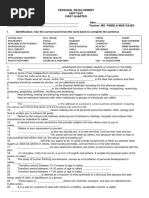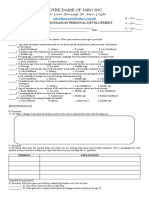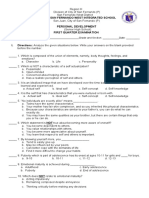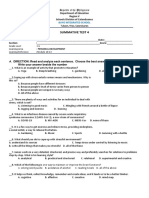Personal Development (Practice Test)
Uploaded by
Sonny B. NabazaPersonal Development (Practice Test)
Uploaded by
Sonny B. NabazaPractice Test
Personal Development - Grade 11
I. Multiple Choice
Direction: Read the following statements. Identify what is described in each number. Write the
letter of the correct answer in the blanks.
_______1. It is accurately assessing one’s feelings, interests, values, and strengths; maintaining
a well-grounded sense of self-confidence.
A. Self C. Self-gratification
B. Self-awareness D. Self-knowledge
_______2. It is the being, which is the source of a person’s consciousness. It is the agent
responsible for an individual’s thoughts and actions.
A. Self C. Self-gratification
B. Self-awareness D. Self-knowledge
_______3. It is the process of self-actualization and learning that combines mental, physical,
social, emotional and spiritual growth.
A. Holism C. Holistic Approach
B. Holistic D. Holistic Development
_______4. It is the tendency in nature to form wholes that are greater than the sum of the parts
through creative evolution.
A. Holism C. Holistic Approach
B. Holistic D. Holistic Development
_______5. It refers to the unique and relatively enduring set of behaviors, feelings, thoughts,
and motives that characterize an individual.
A. Attitude C. Feelings
B. Behavior D. Personality
_______ 6. From the Latin verb, movare, this means to move or be upset or agitated.
A. Attitude C. Emotion
B. Behavior D. Feelings
_______7. It is the person’s thoughts, feelings, and emotions about another person, object, idea
behavior, or situation.
A. Attitude C. Emotion
B. Behavior D. Feelings
_______8. It is a manifestation or acting out the attitudes an individual has.
A. Attitude C. Emotion
B. Behavior D. Feelings
______9. It was derived from the Greek word, "holos", or "whole" which, means to emphasize
the importance of the whole while realizing that the parts are dependent on each other.
A. Camaraderie C. Holistic
B. Esprit de Corps D. Wholeness
_____10. It is something related to a particular culture that is known as a culturally accepted
norms
A. Belief C. Value
B. Thoughts D. Virtue
_____11. The area in Erickson’s Eight Stages of Personality Development wherein the trust vs.
distrust crisis arises.
A. Infancy C. Late Childhood
B. Early Childhood D. School Age
_____ 12. The conflict or crisis that needs to be resolved in the life of the adolescence to be
able to develop a sense of self- identity.
A. Industry vs. Inferiority C. Identity vs. Role Confusion
B. Initiative vs. Guilt D. Intimacy vs. Isolation
_____13. The stages in which an individual reaches the Maturity age (ages 60 and above) of
personal development and develops a sense of fulfillment and wisdom if he is able to
resolve this conflict or crisis.
A. Integrity vs. Despair C. Intimacy vs. Isolation
B. Generatively vs. Stagnation D. Identity vs. Role Confusion
_____14. The stage of Erikson’s Personality Development where a person experiences
Intimacy Vs. Isolation
A. Young Adulthood C. Infancy
B. Late Childhood D. Maturity
_____15. The stage of Personal Development according to Erick Erickson where you belong.
A. Adolescence C. Infancy
B. Young Adulthood D. Early Childhood
II. Matching Type
Direction: Read the following descriptions in column A. Choose the word/phrase that is
described in each number. Write only the letter of your answer in the blank before
each number.
Important Qualities
A B
______16. It is the ability to be truthful and fair. A. Concern and Respect
______17. It is the strength to stand up for what you know B. Courage
is right. C. Good Citizenship
______18. It is being active and helpful member of the community. D. Good Health
______19. It is the willingness to care about others and consider E. Honesty
their feelings, needs, and opinions. F. Integrity
______20. The ability to be dependable, make wise decisions, and G. Responsibility
accept the results of your actions and decisions.
Various Aspects of Holistic Development
A B
_____21. The physical attributes including the five physical senses A. Cognitive
_____22. The intellectual functions of the mind such as thinking, B. Cultural
recognizing, reasoning, analyzing, projecting, synthesizing, C. Physiological
recalling, and assessing. D. Psychological
_____23. It is how thinking, feeling, and behaving interact and happen E. Spiritual
in a person. F. Social
_____24. The manner by which an individual interacts with other
individuals or groups of individuals.
_____25. The attribute of a person’s consciousness and beliefs.
III. Completion (Adolescence Stage)
Direction: Supply the missing words to complete the idea of the paragraph.
Adolescence is the time period roughly the second decade of life. It is a biological
and cultural 26. ______________________ experienced differently across time and culture.
Puberty is the process by which an individual becomes capable of 27. _________________.
It involves growth spurt, weight gain and 28.________________ body composition. It also
involves secondary 29. _________________ development, menstrual periods and sexual
maturity. It is a unique developmental period and it keeps 30. ____________________!
IV. Classifying
Direction: Read and analyze each statement. In the blank before the number, write MA if
the characteristic that is described happens during the Middle Adolescence
stage and LA if during Late Adolescence.
_______ 31. Persistent to the sense of immortality.
_______ 32. Acceptance of the body image is observed.
_______ 33. There is an increase in intensity of emotions.
_______ 34. Intermittent seeking and rejection of parental support.
_______ 35. Idealism and commitment to social causes is common.
_______ 36. Is more able to think ideas through and express himself in words.
_______ 37. Beginning of the gradual realization that others have needs of their own.
_______ 38. The relationship with parents (“adult-adult” interaction) is re-established.
_______ 39. Has the ability to assess the long-term consequences or benefits of actions.
_______ 40. The capacity for intimacy and movement toward more stable relationships is
increased.
V. Enumeration
Direction: Give what is asked in each item. Write your answers in the graphic organizers.
41.43. Three Factors that Influenced Self Esteem
44-47. Causes of Depression
48-50. Causes of Suicide Among Adolescence
You might also like
- Mannoni, Prospero & Caliban (Intro., Ch1)No ratings yetMannoni, Prospero & Caliban (Intro., Ch1)19 pages
- PERSONAL DEVELOPMENT QUIZ Week 1 and 2 ANSWER KEYS100% (2)PERSONAL DEVELOPMENT QUIZ Week 1 and 2 ANSWER KEYS3 pages
- 1st QUARTER EXAMINATION PERSONALITY DEVELOPMENT100% (1)1st QUARTER EXAMINATION PERSONALITY DEVELOPMENT4 pages
- 1st and 2nd UNIT TEST in PERSONAL DEVELOPMENT100% (1)1st and 2nd UNIT TEST in PERSONAL DEVELOPMENT2 pages
- Personal Development Grade 12 - Weekly Assessment 1100% (1)Personal Development Grade 12 - Weekly Assessment 14 pages
- Course Syllabus in Primary Health Care 1No ratings yetCourse Syllabus in Primary Health Care 17 pages
- Personal Development Summative Test For Week 2100% (2)Personal Development Summative Test For Week 21 page
- Tipas National High School (SHS) Second Quarterly Examination in Personal Development Grade 11 School Year 2017-201892% (13)Tipas National High School (SHS) Second Quarterly Examination in Personal Development Grade 11 School Year 2017-20183 pages
- I. Direction: Read The Questions Carefully. Encircle The Letter of The Best Answer0% (1)I. Direction: Read The Questions Carefully. Encircle The Letter of The Best Answer4 pages
- Summative Test in Personal Development Final50% (2)Summative Test in Personal Development Final4 pages
- Personal Development Grade 12 - Weekly Assessment 1100% (1)Personal Development Grade 12 - Weekly Assessment 13 pages
- Bado Dangwa National High School Personal Development Q1-2nd Summative Test100% (1)Bado Dangwa National High School Personal Development Q1-2nd Summative Test1 page
- PERSONAL DEVELOPMENT LESSON PLAN (Developing The Whole Person)100% (2)PERSONAL DEVELOPMENT LESSON PLAN (Developing The Whole Person)3 pages
- Perdev Coping With Stress in Middle and Late Adolescence75% (4)Perdev Coping With Stress in Middle and Late Adolescence3 pages
- Summative Test 4: Buyo Integrated SchoolNo ratings yetSummative Test 4: Buyo Integrated School2 pages
- Table of Specification Personal Development100% (2)Table of Specification Personal Development1 page
- Maximo T.Hernandez Memorial Integrated High School: Department of Education Division of Batangas District of Ibaan100% (1)Maximo T.Hernandez Memorial Integrated High School: Department of Education Division of Batangas District of Ibaan2 pages
- Saint Rose of Lima School, Inc. S. Y. 2021 - 2022 1st Unit Test Personal Development 12No ratings yetSaint Rose of Lima School, Inc. S. Y. 2021 - 2022 1st Unit Test Personal Development 123 pages
- Personality Development (Midterm Assessment)No ratings yetPersonality Development (Midterm Assessment)3 pages
- Reaction Paper: Pirote, Joshua A. CBET-01-303PNo ratings yetReaction Paper: Pirote, Joshua A. CBET-01-303P3 pages
- Validation of The Five-Factor Model of Personality Across Instruments and ObserversNo ratings yetValidation of The Five-Factor Model of Personality Across Instruments and Observers10 pages
- The Use of Mixed Methods in Management ResearchNo ratings yetThe Use of Mixed Methods in Management Research6 pages
- The Formation of The Gospel Tradition Taylor, Vincent, 1887-1968No ratings yetThe Formation of The Gospel Tradition Taylor, Vincent, 1887-1968230 pages
- Full Download Welcome to AI What Is Artificial Intelligence and How Will It Change Our Lives Owen Davey PDF DOCX100% (2)Full Download Welcome to AI What Is Artificial Intelligence and How Will It Change Our Lives Owen Davey PDF DOCX81 pages
- Foundation Writing Mark Sheet: Question 1 (20-30 Words) - 12 MarksNo ratings yetFoundation Writing Mark Sheet: Question 1 (20-30 Words) - 12 Marks1 page
- Steps For Completing The Performance Appraisal Form: GP 247 (Revised 2006)50% (2)Steps For Completing The Performance Appraisal Form: GP 247 (Revised 2006)7 pages
- Kasus Perubahan Dalam Perusahaan Keluarga: PT. Solo Jaya67% (3)Kasus Perubahan Dalam Perusahaan Keluarga: PT. Solo Jaya10 pages
- Expressing Advice: by Using Modals: Should', Ought To', Had Better'No ratings yetExpressing Advice: by Using Modals: Should', Ought To', Had Better'4 pages
- PERSONAL DEVELOPMENT QUIZ Week 1 and 2 ANSWER KEYSPERSONAL DEVELOPMENT QUIZ Week 1 and 2 ANSWER KEYS
- Personal Development Grade 12 - Weekly Assessment 1Personal Development Grade 12 - Weekly Assessment 1
- Tipas National High School (SHS) Second Quarterly Examination in Personal Development Grade 11 School Year 2017-2018Tipas National High School (SHS) Second Quarterly Examination in Personal Development Grade 11 School Year 2017-2018
- I. Direction: Read The Questions Carefully. Encircle The Letter of The Best AnswerI. Direction: Read The Questions Carefully. Encircle The Letter of The Best Answer
- Personal Development Grade 12 - Weekly Assessment 1Personal Development Grade 12 - Weekly Assessment 1
- Bado Dangwa National High School Personal Development Q1-2nd Summative TestBado Dangwa National High School Personal Development Q1-2nd Summative Test
- PERSONAL DEVELOPMENT LESSON PLAN (Developing The Whole Person)PERSONAL DEVELOPMENT LESSON PLAN (Developing The Whole Person)
- Perdev Coping With Stress in Middle and Late AdolescencePerdev Coping With Stress in Middle and Late Adolescence
- Maximo T.Hernandez Memorial Integrated High School: Department of Education Division of Batangas District of IbaanMaximo T.Hernandez Memorial Integrated High School: Department of Education Division of Batangas District of Ibaan
- Saint Rose of Lima School, Inc. S. Y. 2021 - 2022 1st Unit Test Personal Development 12Saint Rose of Lima School, Inc. S. Y. 2021 - 2022 1st Unit Test Personal Development 12
- Validation of The Five-Factor Model of Personality Across Instruments and ObserversValidation of The Five-Factor Model of Personality Across Instruments and Observers
- The Formation of The Gospel Tradition Taylor, Vincent, 1887-1968The Formation of The Gospel Tradition Taylor, Vincent, 1887-1968
- Full Download Welcome to AI What Is Artificial Intelligence and How Will It Change Our Lives Owen Davey PDF DOCXFull Download Welcome to AI What Is Artificial Intelligence and How Will It Change Our Lives Owen Davey PDF DOCX
- Foundation Writing Mark Sheet: Question 1 (20-30 Words) - 12 MarksFoundation Writing Mark Sheet: Question 1 (20-30 Words) - 12 Marks
- Steps For Completing The Performance Appraisal Form: GP 247 (Revised 2006)Steps For Completing The Performance Appraisal Form: GP 247 (Revised 2006)
- Kasus Perubahan Dalam Perusahaan Keluarga: PT. Solo JayaKasus Perubahan Dalam Perusahaan Keluarga: PT. Solo Jaya
- Expressing Advice: by Using Modals: Should', Ought To', Had Better'Expressing Advice: by Using Modals: Should', Ought To', Had Better'

























































































